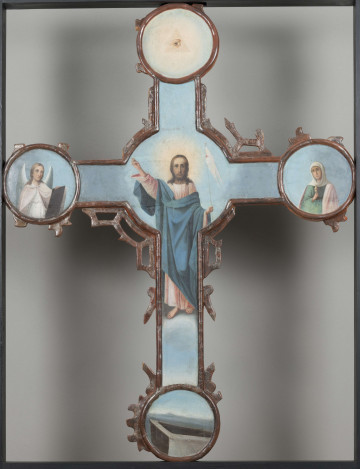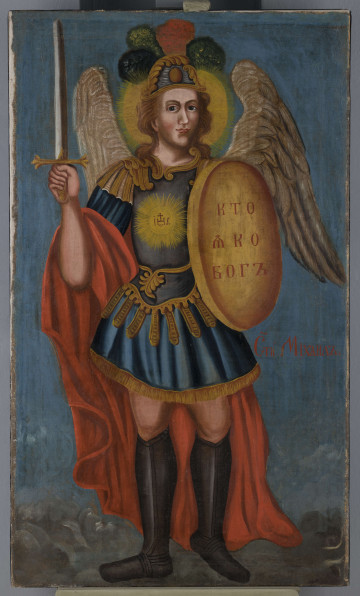
Christ Pantocrator
1801 — 1900
National Museum in Lublin
Part of the collection: Folk Art of the Lublin Region (17th–1st half of the 20th c.)
There are various depictions of Christ in Orthodox iconography: the Acheiropoietos ("not made by human hand", in the form of the face), the Saviour in majesty, Emmanuel (in youth), the Great High Priest (in priestly robes), the Old Testament Christ (pictured as the grey-haired Old God), the Blissful Silence Christ (under the form of a young man with wings as the Angel of the Great Council). Most often, however, he is depicted as Pantocrator - the Omnipotent One, Lord of all, Judge of the Universe.
This iconographic type, one of the oldest, which has hardly been transformed since the 6th century, usually depicts the Saviour in a semi-pose, standing or seated on a throne, with the Scriptures open in his left hand and his right hand raised in a gesture of blessing. The Book refers to the teaching mission, while the arrangement of the fingers to the Greek monogram of Christ: IC XC. By joining the thumb with the heart finger, the index finger and the bent middle finger resemble the letters IC. Crossed diagonally, the thumb and the ring finger together with the little finger form XC. This is not the only interpretation of the gesture, according to some theologians the joined thumb and middle finger are a symbol of the duality of Christ's nature: divine and human. And the joining of three fingers - the little finger, the heart finger and the thumb - symbolises the Holy Trinity. The colours also have symbolism. The blue colour of the mantle (himation) indicates divine majesty, the red of the lower robe (chiton) is the colour of martyrdom and resurrection, and the golden nimbus with rays around the head stands for light, brightness and the glory of God.
In the Orthodox tradition, the representation of Christ as Pantocrator is most often placed on the vault of the central dome of the church. This placement points to Jesus, who from on high looks at the world with eyes full of thoughtfulness, love and mercy. As an icon with the image of the Teacher, it is placed in the first row of the iconostasis, to the right of the Tsarist gates, among the icons of the governors. Sometimes, when it depicts the Throned Christ accompanied by the intercessors of the people: Mother of God and St John the Baptist, it may be in the top third row, i.e. Deesis, which expresses the idea of prayer and intercession for humanity.
Author / creator
Dimensions
cały obiekt: height: 17 cm, width: 23 cm
Object type
painting icon
Technique
painting technique
Material
plank, tempera
Creation time / dating
Creation / finding place
Owner
The National Museum in Lublin
Identification number
Location / status

1801 — 1900
National Museum in Lublin

1801 — 1900
National Museum in Lublin

1801 — 1900
National Museum in Lublin
DISCOVER this TOPIC
Museum of King Jan III's Palace at Wilanów
DISCOVER this PATH
Educational path